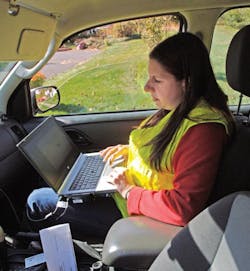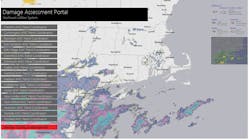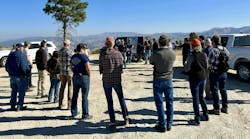Connecticut has seen its fair share of extreme weather over the past few years, with hurricanes and fierce snowstorms wreaking havoc on the electric system. Restoring power after devastating storms is painstaking work that takes time. To speed the restoration process, Connecticut Light & Power (CL&P) is integrating a new damage-assessment system with its existing outage management system (OMS). The new damage-assessment tool will improve the speed and accuracy of storm response by allowing storm patrollers to report specific information about the extent of damage in a timely fashion so crews can be deployed efficiently with the resources needed to make repairs.
To develop the new damage-assessment system, CL&P teamed up with Clearion Software, LLC, a developer specializing in GPS-enabled technologies for utility vegetation. The goal was to develop a tool that would allow patrollers to transmit detailed damage assessments quickly from remote areas back to an operations coordinator, who would use the information to plan and execute restoration.
The solution developed by CL&P and Clearion arms patrollers with laptops enabled with Wi-Fi and GPS. While there is nothing new about using laptops in the field, these computers are loaded with 600 MB of detailed geographic information system (GIS)-based infrastructure information, making CL&P one of the first utilities in the United States to use this technology to speed restoration.
Assessing and Reporting Damage
CL&P’s distribution system is 17,000 miles — the approximate roundtrip distance between Boston, Massachusetts, and the Philippines — and consists of several local electric systems that have evolved and been consolidated over the past 100 years. With more than five different operating voltages, large-capacity substations, relatively lengthy distribution circuits and automated loop schemes, and distribution supervisory control and data acquisition (DSCADA) intended to improve reliability, restoring power in Connecticut can be a complex operation.
With these challenges in mind, a core team of CL&P experts worked directly with Clearion to customize the software for the utility’s intricate distribution system. The software combines CL&P’s GIS mapping data with information about the distribution system and equipment as well as GPS street location data to streamline the patroller’s job. Using GPS tracking, or by keying in a street location, the software provides a detailed depiction of the distribution infrastructure as the patroller travels the circuit.
When damage is found, the patroller simply clicks on the asset and a pop-up window opens that provides detailed information, including system identification, nomenclature and asset attributes. Reporting damage can be done easily and accurately using the context-specific damage reporting window with drop-down menus.
Before this new technology, patrollers worked from large-paper circuit maps and recorded damage manually on paper forms. For example, details about a damaged transformer, such as the voltage and kilovolt-amps, were manually gleaned from a circuit map and a patroller’s own knowledge of the system. Most hard-copy damage assessments were then driven from the field to a work center toward the end of an 8-hour shift and manually input to CL&P’s OMS — a process that took additional hours to complete.
Hours were reduced to seconds in January 2013 as 10 patrollers tested a Web-based version of the assessment tool in the field using laptops equipped with air cards. Based on positive feedback from the pilot experience, the CL&P–Clearion team took the tool to the next level by installing the 600-MB software on Wi-Fi/GPS-enabled laptops and integrating the software with CL&P’s OMS.
Identifying Trouble Spots
Using this new mobile technology, patrollers are able to assess a greater number of trouble spots, making the patroller far more productive and effective in providing critical assessment information. OMS then processes the data in real time, immediately providing OMS modelers with information needed to confirm system configuration. Next, the OMS posts and summarizes damage information for each trouble spot, allowing the restoration to begin sooner.
Customized reporting provides key information required to develop response and restoration strategies. CL&P also creates detailed crew work packages, including notated circuit maps, to streamline the work management aspects of restoration.
If a patroller drives into an area without cell phone service, the software will store damage information and forward it to the coordinator as soon as the patroller enters an area with a signal or has access to a public Wi-Fi connection.
Patrollers and coordinators are now able to keep in constant contact, enabling the coordinator to bundle trouble spots and dispatch patrollers more efficiently, reducing driving time. This is a significant advancement, as Superstorm Sandy had caused more than 16,000 trouble spots that required the trained eye of a patroller to analyze them before resources could be assigned for repairs.
Line workers, tree crews and materials also are assigned more efficiently to repair trouble spots when dispatched, and materials reports can be generated from the tally of broken crossarms, transformers and poles, and be organized by locations, enabling CL&P warehouse personnel to direct stock efficiently to the hardest-hit areas.
Timely, accurate damage information following a severe storm can shave days off a large-scale electric utility restoration. Damage assessment is critical for resource deployment, planning, scheduling and providing customers and communities with power-restoration estimates as soon as possible. With this new technology-focused approach to damage assessment, CL&P can drive improvements throughout the restoration process and will be even better prepared for whatever the next hurricane season may bring.
Alan Carey ([email protected]) is the project manager for Connecticut Light & Power’s damage-assessment process. His responsibilities include implementing the new Clearion damage-assessment technology and related processes to the utility’s damage assessors and supporting staff. He has been with CL&P for 20 years and most recently served as an operations manager and supervisor of vegetation management.
Companies mentioned:
Clearion Software | www.clearion.com
Connecticut Light & Power | www.cl-p.com





